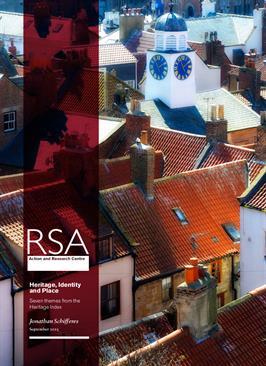The Heritage Index reveals a wealth of data about heritage in England, Scotland and Wales.
What can data reveal about Britain's heritage?
How to get involved in your local heritage
While the best way to explore the data is through interactive online maps, this short report focuses on seven themes of analysis. The rich understanding generated can help forge a stronger link between heritage and the identity of residents in a place. This can help a place achieve its aspirations to grow and prosper, socially and economically.
After crunching together over 100 datasets it is clear there are some star performers, beyond the predictable list of well-preserved historic cities and pristine landscapes. Heritage is as much about the scale and intensity of activities that bring history to life, as it is about traditional buildings and sites with protected status.
The data allows several common myths about heritage to be shattered: local areas rich in heritage exist in both the wealthiest and most deprived corners of Britain. Benefiting from a local focus, the Index shows heritage is as strong in rural areas as in urban areas, and any concerns about a north-south divide are misplaced. While London has boroughs with among the highest heritage scores, Liverpool outperforms all other major cities across England. And as a clear reminder of our identity as island nations, we also find that coastal areas perform particularly well in our Index, with extensive natural heritage assets.
We compare the Heritage Index results with what we already know about the benefits of heritage to citizens. Analysis shows that places with high levels of heritage activity are positively correlated with places with high well-being among residents Comparing heritage assets with heritage activities allows us to shortlist places with the greatest opportunity to increase the involvement of people with heritage.
We conclude by considering how people could work to build upon this first Heritage Index. This includes improving the data they collect, celebrating the intangible heritage of local places, and taking action to ensure that heritage is accessible to local people and an active part of local identity. A stronger understanding of local heritage can help ensure that what is considered important is taken into account by those who influence how a place develops.
Communities Minister Marcus Jones said:
Britain has a history envied across the world and it’s great to see that – through the Heritage Index – communities can now discover how to make the most of that history to drive growth in their local area.
What’s more, I would encourage local people to use the protections provided by community rights to list their local heritage assets and ensure that the next generation can continue to enjoy our past.
We conclude by considering how people could work to build upon this first Heritage Index. This includes improving the data they collect, celebrating the intangible heritage of local places, and taking action to ensure that
Find out more about Heritage,
pdf 1.9 MB
Contributors


Join the discussion
Comments
Please login to post a comment or reply
Don't have an account? Click here to register.
Simon Ball did a projects on maps by taking walks around I think London it was. Anyhow he has a similar but not exactly the same aesthetic approach to the heritage index and I think it has something to do with the physical act of walking. On another article I read, this was his dissertation by-the-way, anyhow I think locally heritage means something more when one is either a tourist wanting the soak in the culture or someone living in the community. But this isn't always the case. Living in the Caribbean meant a lot of sun for me, but the culture was different than what I was exposed to at the time. For instance, I didn't get a chance to notice the natural environment becayse I was there to mediate on the social and economic impact of industrialization which I am told they have since been able to implement. Hence, the heritage of England and Britain as a whole has significant historic impacts which can be implemented today. Thus, for a probing thought if I may - does the fauna of heritage sites affect the livability of the sites - for instance in the Caribbean, the tarantula population increased, in which they never developed fur and after industrialization they had. Are these sites more or less livable?
I have found it fascinating exploring this and the other related web pages and reports. However, I have been trying to find a convenient contact email as I have several questions about the project but can't find one. Fo example, the technical report refers to 100 indicates and weighting being available and gives a weblink but I can't find them there. I would also like to know why archaeology is only represented by finds and scheduled monuments. What about the huge numbers of archaeological sites on the Historic Environment Records which don't seem to have been included.
Paul, the link at the top of this page 'Download the Data' will let you see all the indicators, with links to original sources and figures on the weightings which we gave.
It's a long story with regards to Historic Environment Record: a technical challenges (many seperate databases ie county-level) and a philosophical one (is it reductive to simply count the number of objects in an HER as an indicator of richness of heritage, given the variability between HERs in what they record?). I am sure we will talk to ALGAO in coming months!
You can email me: [email protected].